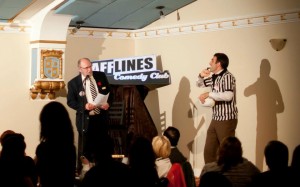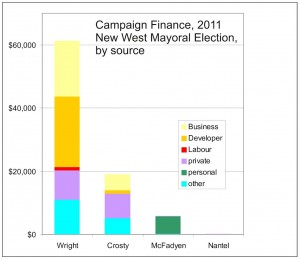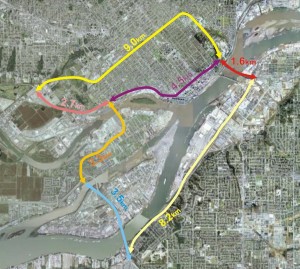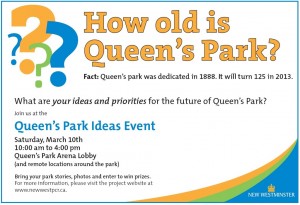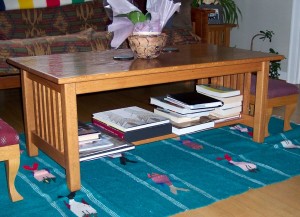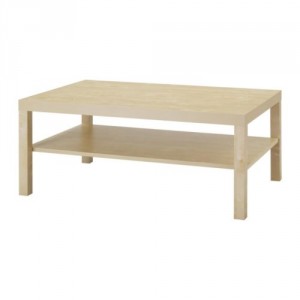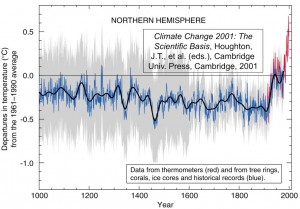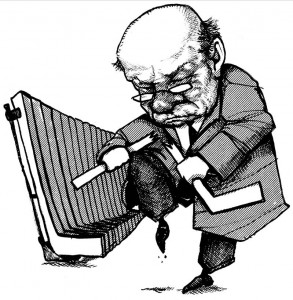Category: NWimby
Best Reason Ever to Stop Protecting Habitat.
Oh, I feel better. The Minister of Fisheries has a good reason to tear up the keystone environmental regulation in the country, and it had nothing to do with Oil Pipelines of Bituminous Sands development:
“Ashfield countered with examples of what he suggested were excesses under the act, citing one instance last year when a country jamboree in Saskatchewan scheduled to take place in a field that was flooded was almost cancelled because there were some fish in it.”
Yep, they almost had to cancel a Country Jamboree in Podunk, Saskatchewan because the asshat organizers planned for everyone to camp on a field with water deep enough to support fish… and it is the Department of Fisheries fault for ruining everyone’s hoe-down heel-kicking two-stepping good times. This from the mouth of the Minister of Fisheries, in the House of Commons!
Of course, they didn’t cancel. The show (for what it is worth) went on. No Country fans were inconvenienced, amd they are doing it again this year. No-one is reporting on what happened to the fish, and no mention of whether this year’s Jamboree will include a fishing derby.
It might be funny if this wasn’t about tearing up the single most effective environmental law in the Country. This is seriously not funny any more.
Fishy Fishing with the Fisheries Act
You know, I have been railing against the Harper Government for so long that it is even boring for me. I was one of those people after the last election thinking: well, how bad could their majority really be? Sure, he will continue to harm the economy by throwing more eggs in the Oil basket, and cutting taxes on the wealthy to create false crises as an excuse for future gutting of social programs, but he is a cagey politician and pretty shrewd, so he won’t go too far, lest Canadians get itchy and dispatch him next election. Maybe in the meantime, he will actually bring on some promised Senate or electoral reform or cut those MP Pensions. Remember Steve, your Reform Party mantra? that could be helpful in the long-term. I mean, it is only 4 years. How much harm can he do?
Then this story comes along.
To the uninformed, this seems rather innocuous to remove “habitat language” from the Federal Fisheries Act. To people who work in the Environment field, this is a huge thing.
Simply put, the Fisheries Act is the strongest piece of environmental legislation we have in Canada. It overrides all Provincial and Municipal legislation, it is so powerful that even the railways have to follow it – yes, even the Railways! It serves as the primary protection of fresh and marine water quality and aquatic habitat in the Country. From filling ditches in Queensborough to building the Site C Dam, the Fisheries Act is involved. The potential replacement of the Pattullo Bridge, and even the spill response measures for maintaining the bridge, invokes the Fisheries Act. Don’t take me word for it, ask any Envrionmental Professional you know – P.Geo., P.Eng., R.P.Bio, ask then what Canadas most important Environmental Legislation is, 80% will say “Fisheries Act”. (Most of the other 20% will say Species at Risk Act, until you suggest the Fisheries Act, then they will correct themselves. Go shead, try it. If I’m lying, I’ll buy you a pint.)
Because of the Fisheries Act, there are two terms that are ubiquitous in environmental protection in Canada: “deleterious substance” and “HADD”.
The first is what I deal with primarily. According to Section 36(3) of the Fisheries Act, no-one can deposit or allow to be deposited any “deleterious substance” into waters frequented by fish or in any place where the substance may enter water frequented by fish. As for what constitutes a “deleterious substance”, that relies on a pile of guidelines, standards, and reports backed by a huge pile or scientific research on different materials. I deal with this section of the Fisheries Act every day of my working life.
The second part is clearly an acronym: Harmful Alteration, Disruption, or Destruction. Section 35(1) of the Fisheries Act says:
No person shall carry on any work or undertaking that results in the harmful alteration, disruption or destruction of fish habitat.
Basically, everything you do in or near an open watercourse that has fish in it, you need to be mindful that there may be fish present, and not harm the environment in a way that harms fish. This provided defacto protection to aquatic birds, invertebrates, amphibians and countless important plant species, while providing an extra level of protection to the quality of the water in our lakes, rivers, and oceans.
You know, that foundations of the ecosystem stuff.
Section 35(2) says that the Minister (or a Governor in Council under any other Act) may grant approval for a HADD. So even this hard and fast rule is really nothing more than an “irritant” for most. It doesn’t stop oil and gas or pipeline development (at least it never has up to now). In essence, every bridge is a HADD, but you don’t see us not building bridges. However, if your works create a HADD you must compensate for that lost habitat, and that almost always means by improving the quality of some nearby adjacent habitat so there is “no net loss” of habitat.
You want to build a ferry slip on this 20m of pristine foreshore? Then spend some money restoring that 20m of hardscape shore over there, and we’ll call it even. Want to put a span bridge across this ditch? Then do a little invasive species management in the riparian area beside the bridge and there will be no net loss. All very reasonable: do your business while protecting habitat. Win-win. These terms are negotiable, and are negotiated every day across the country by fish protection officers. Fish habitat compensation is rarely a significant portion of the capitol cost of a development. If it is, then there is usually a problem with development that needs to be fixed (see Prosperity Mine example).
Of all legislation to protect the environment in Canada, this one is the most straight-forward, the most protective, the most firmly established, and the easiest to understand. Like few things in Government (especially around the environment file), it works! Every Environmental Scientist working in Canada, and most Professional Geoscientists and Engineers who work in or near water, know the words “deleterious substance” and “HADD” and know how to apply them, they have been the law of the land for something like 30 years. Why change it? Is no net loss too much to ask for the Billions of dollars that oil sands development are exporting every year? And why fillet the most important peice of Envrionmental Legislation in the country as part of an Omnibus Budget Bill? How cynical do you have to be to catch these guys?
This laws is so fundamental that most Provincial and Municipal regulation protecting the local environment are designed to specifically dovetail with it, as are Acts regulating farming, forestry, marine navigation, Environmental Assessment… Changing the Fisheries Act language on Habitat may throw all of this other legislation into chaos.
And it may spell the end to our already threatened natural salmon stocks.
…would distract from those “fishy” phonecalls, though.
Elizabeth May tweeted from the House of Commons (at 2:43PDT this afternoon) that rumours have this coming from the PMO, not DFO. That seems obvious, because no-one with a passing knowledge of Fisheries legislation or fisheries science would suggest such a ridiculous change. This is dumb, irresponsible, thick-headed, a really, really bad thing. I have to admit, I never imagined they would do this much harm. I still don’t.
A little idea around Daytime Savings
We all hate springing forward. This week is full of stories of people sleeping in, hating the loss of sleep, having to drag their kids out of bed for school. Let’s put aside for a bit the idea that we are so stressed as a society that losing as little as one hour of sleep causes irreparable harm to our consciousness…
Yet we all love gaining that extra hour of sleep in the Fall. So the problem isn’t daylight savings, it is the “springing forward” part. So let’s fix that.
I propose we move the March time change from 2:00am on Sunday to 2:00pm on Friday.
Think about it. Instead of losing and hour of sleep, we miss an hour of “wake”, effectively increasing our proportional sleep time over the weekend. And by doing it on a Friday afternoon, everyone gets a well-deserved hour off of work/school, and gets to go home 1 hour earlier to enjoy the longer days. What’s more, everyone is awake, so none of this being late for stuff because you forgot to change your clock when you went to bed. No need to change the “Fall Behind” part, as everyone likes more sleep, and showing up an hour early for something gives us all-important self reflection time.
I would even sacrifice Premier McSparkle’s just-in-time-for-election “Family Day” for this smallest of all mid-March vacations.
Tell your friends, tell your elected officials. You heard it here first. Let’s fix Daylight Savings for the good of society.
Trucks on Royal
This is an issue that bubbled a bit during the last election. Most notably, Council Candidate Vladimir Krasnogor raised the issue of heavy truck traffic on Royal Avenue throughout the campaign. The issue didn’t seem to have legs, though.
I used to live on Royal Ave and 10th: a great condo in a great building. Our first experience with Condo ownership was a surprising success, mostly because the Strata Council was proactive, with a few very sharp members who were able to manage the books and keep the ship running. The only downside of the place was intersection of Royal and 10th. The pavement was pretty beaten up, with a huge volume of heavy trucks causing the asphalt to ripple dramatically. Although the route is only a “daytime” truck route, it only takes a few scofflaw drivers to give people the impression it is a 24-hour truck route. Laden trucks grinding up Royal between 10th and 8th were bad enough, but the crash bang of (seemingly empty) container trucks rattling over the rippled pavement while racing through the intersection on the downhill route can shake you filings out, and that one-in-a-hundred jake-brake user during a quiet summer night paints all drivers with a bad brush, even from 20 stories up.
I sympathized with the folks at City Hall even when I was phoning to complain, yet again, about the guy in the Celeste green wood chip truck with the wailing brakes who drove down the hill, wailing away, yet again, at 5:00am. The City Bylaw Officers did what they could with enforcement, but it was an endless game of whack-a-mole.
What are you going to do? Trucks are necessary for the operation of our society. Royal is on the Major Road Network, and therefore Metro provides money to maintain it, and they are not likely to remove this route from the MRN unless viable alternatives are provided. I hear people at the Master Transportation Plan open houses talking about how “cut and cover” is the solution to all truck traffic issues, without acknowledging the costs and other logistical issues (not to mention the tradeoffs) that come with those types of hard, expensive, engineered solutions in urban areas.
This intractable issue has come up again, as part of the discussions around the Pattullo Bridge. Like many lightly-scabbed-over intractable problems, an off-hand comment from Matt Laird peeled it open again, and got me thinking about the problem in a different way. While looking at the various off-ramp designs TransLink had offered us for their new Bridge, Matt asked why trucks had to turn right onto Royal from the bridge. I’m not sure anyone in the room got what he was talking about, but for the last couple of weeks, that question has been stuck in my head like the baseline of “The Lion Sleeps Tonight”. There. Now it’s in your head too.
So I got thinking about the question, and came up with this handy little diagram.
This measures the distance between key points relating to truck movements around Royal Avenue. I’m assuming that the South Fraser Perimeter Road will be completed and the Pattullo Bridge (in whatever shape or format) will continue to connect to East Columbia and Royal near McBride. The numbers indicate the distances between the important node points. So the distance from 124th and King George in Surrey (the intersection of the SFPR and Highway 99A) to the north foot of the Queensborough Bridge via Royal is 1.6km + 4.5km, or 6.1km.
So let’s look at what options truck drivers have while crossing the Pattullo Bridge (for the time being, lets ignore the trucks that have specific business in New Westminster, and talk about the through-traffic only).
Arriving at the Hwy99A/SFPR intersection from any direction, any truck heading to the TriCities is pretty likely to take the Pattullo, as the asshats at MOTI have decided not to connect the two most expensive road-building projects in the Province (Port Mann 2 Hwy 1 and the SFPR) with an intersection where they cross. These trucks will therefore be forced to cross the Pattullo, take East Columbia, and get mired in the Brunette / Braid intersection and Brunette overpass hijinks. (note, the UBE would definitively NOT have solved this problem, as the trucks want to get to the 8-lane Lougheed or the 10-lane freeway, not to a driveway-laden 4-lane service road through big box retail and casino entertainment hell)
Trucks heading to the northwest will typically stay on 99A up McBride. The only trucks taking Royal would be those heading west to the Queensborough Bridge intersection: the aforementioned 6.1km trip. If their destination is along Marine to points west, the logical alternative is to continue up McBride to 10th, then go down Southridge Drive to Marine at Byrne Road: a trip of 10.6km, which is only slightly longer than the Royal route (which is 8.9 km total). If their destination is the East-West Connector, then their option is the SFPR – Alex Fraser route, which is 11.7km compared to 9.4km along Royal. Considering the SFPR route will all be separated freeway, and not involve stop-and-go traffic lights, even most destinations in Queensborough might be better serviced from the southern route.
Now what about trucks coming from the E-W Connector? The only reason for them to use the Pattullo is to access the TriCities if they choose the longer Alex Fraser – SFPR – Pattullo route, which is quite a bit longer (13.3km) than the Stewardson – Columbia route (7.8km), so not likely. More importantly, if their destination is south of the River, they might be best off to cross the Alex Fraser right away, as they will get to Surrey sooner (11.7km of freeway vs. 9.4km of City streets), so no Pattullo access needed at Royal.
Coming from Marine Drive, the only reason for trucks to use the Royal-Pattullo route is to get to Surrey, and Royal is only one of the three options (Royal is 8.9km, 10th and McBride is 10.6km, and Queesnborough is 17.7km).
So again, except for local traffic, why do trucks need to be able to access Royal from the new Pattullo? Is a 10% longer route along less-restricted roads faster than a shorter route with hills, stoplights and commuters?
I guess one point to take out of this is that we need to understand the ultimate routing of these trucks, in order to service them adequately, not just whether a truck is “local” or not. If only 5% of the trucks are using Royal Avenue because it is a significantly better routing than any alternative, but because of that 5%, we build Royal into the quickest route, then that will attract trucks off of the alternative routes that are only slightly longer. We also have to ask the hard question: is accommodating those 5% of trucks worth the cost to the livability of our City?
These questions require better data to answer. As does the “local truck question”: are there better alternatives to service the trucks whose destination is New Westminster, separate from the through-traffic? Remember, “truck routes” only apply to through traffic (trucks with local business are not limited to these routes, but can use service roads to access businesses that are not on truck routes).
Maybe Matt and Vladimir are right – maybe it is time to start talking about taking Royal off of the MRN. Could such a move be timed to coincide with the opening of the SFPR? Would such a move put the Pattullo replacement project into a new light?
Queens Park Master Planning
I love Queen’s Park. Not the neighbourhood I can’t afford (although that is very nice), but the Park itself. Sitting in the beer garden during Hyack, jogging the Centennial Trail during my occasional brief forays into fitness, walking though the hazy park after midnight on my way home from the Curling Club, even the occasional NWEP open-air meeting during the summer. Just looking at New Westminster from space (via Google), it is the square rectangle of green in the middle of Urbania that sets the geography of the City- even as it contrasts with the angry sharp finger of green that is Glenbrook Ravine.
It is the contrast with Glenbrook Ravine that speaks to the meaning of the word “Park”. The word is used to describe any generically green space in a urban environment, or otherwise protected space in other environments. There has always been a bit of dichotomy between park space being “preserved”, or set aside for nature, and park space being “programmed” for human appreciation of nature. Look at the protests about a rather innocuous walkway in Jasper, or the “No National Park” signs throughout the Similkameen Valley for examples of the conflict between how “Park Space” is valued or not by groups in our society.
Glenbrook Ravine is a pretty wild place, all trees and brush, a green sanctuary for flora and fauna (and overrun by invasive species), where few people wander off the one or two trails. In contrast, Queens Park has seen 125 years of poorly-planned development, the result a criss-cross of playing fields, paved and unpaved trails, parking lots and buildings. Even much of the Green Space is not actually plants, but painted plastic.
The City’s Parks and Recreation Department recognizes that much of the development of the park has been rather ad-hoc, with little long-term planning. So they are looking at changing that, and are launching a Queens Park Master Plan process, to make sure the park’s utilization is optimized in the future.
Much like the Master Transportation Plan, this process is going to take a few months and involve various steps and lots of public consultation. This first step for public input is this coming Saturday, with an “Ideas Event”.
Parks and Rec are encouraging everyone to come out an provide some ideas about the future of Queens Park – what do you like or not like about the current Park? What do you want osee happen to the park?
I have my own loves and hates with the park. I think the long-term preservation and management of the Really Big Trees is important for all sorts of reasons. I am less particular about the rest of the manicured gardens: I know the Rose Garden has a proud tradition, but I would love to see an area dedicated to the growing and preservation of important threatened species of native plants.
Upgrading the driving and parking areas to make them a little more, uh… “park like” would be a nice. Unfortunately, the area between the Stadium, the Arenex and the Arena is a pretty dismal asphalt jungle now, and that is (for many people) the first impression of the park that people get.
The Parks works areas are also a little disappointing in a setting as beautiful as Queens Park. The entire fenced-off maintenance areas both disrupt the park-like setting, and make wandering around the park less pleasant. I would add the petting zoo area to this list of strange disruptions. Again, I may be in the minority here, but I think the petting zoo concept is an idea well past it’s prime.
I like the idea of the Bandshell more than I like the actual Bandshell. Having enjoyed great concerts at the Malkin Bowl and Deer Lake Park, I can’t help but think we need a better outdoor venue in New West. Maybe the Bandshell just needs and upgrade, or maybe these types of events will move to the new Pier Park?
The picnic areas are so well used in the summer, that it is sometimes hard to find a spot unless you book well ahead. I think a few other less-structured sitting-and-meeting spaces could be integrated all around the Centennial Trail.
I think the Stadium is spectacular and under appreciated for its setting. I wish I had more reasons to go see Games at it (oohhh… imagine a Single-A baseball team?!? Line me up for season’s tickets!)
Ultimately, I don’t think Queens Park needs any radical changes, but subtle upgrades as the aging infrastructure is being replaced. As population density to the east of the park goes up, and property values to the west stay high, there will be more demand on Queens Park. At the same time, the new Pier Park may draw a lot of the picnic and other “programmed” uses away. Connecting the two via greenway trails, including the upgraded trails through Glenbrook Ravine, would make a nice connected green region of the City… but maybe I’m dreaming now.
the Dollar Store Debate.
OK, I will wade into it.
This was touched off by a minor local Twitterstorm last week, when some lamented the opening of yet another “Dollar Store” in New Westminster. Some had the temerity to suggest that miscellaneous discount crap fresh off the container from East Asia was not a product category of which New Westminster was suffering paucity.
Ever-opinionated, usually correct, and fiercely local Twitterista Jen Arbo was quoted in the Record lamenting that this was the best our local retail environment could offer. The counter argument being, I guess, all hail the free market and the entrepreneurs for which it stands. I have to count myself on the Arbo side of the discussion, but had little to say on the issue. I don’t go into Dollar Stores, because they have nothing to offer me, although they apparently offer something to others: go, go, free market!
Then I noticed the Record article quoted a New York Times article thusly:
“We are awakening to a dollar-store economy,”
…and I shuddered. I cannot think of a more damning lament for our economy, or for our society. No I gotta comment.
This “Dollar Store Economy” is one where the retail environment is dominated by bountiful cheap choice. If you cannot find the quality or the features you want, that is offset by the remarkable affordability of what you don’t want. As the times article points out, it is the “Luxury of Quantity”. Tired of crappy stuff? Here is some more crappy stuff. This is the foundation of the economy that makes Wal-Mart the largest retail business in the world, and IKEA the largest seller of home furnishings in the world. This is the philosophy that brings us 5000-square-foot plywood McMansions in neighbourhoods without sidewalks, straining the City’s ability to provide basic services, while the homeowner laments outragrous 2.5% property tax increases. This is the philosophy that makes it profitable to burn the crap we import and pay a dollar each for more when we find a more pleasing colour the next day.
This also creates the market condition where it is difficult to shop in New Westminster if you want to shop locally and support the local economy. Outside of Wal-Mart, there is no place to buy sporting goods in New Westminster. We have two very good bike shops, but not one place to get a decent selection of running shoes. We host the Canadian Lacrosse Hall of Fame and one of the greatest Lacrosse teams in the history of the sport, but you cannot buy a lacrosse stick within our 15 square kilometres. The same lament for people trying to buy office supplies, gardening equipment… the list goes on.
The big-box merchants at our periphery provide a dizzying supply of low-quality replacements for all of the above. Think about it: one sure way to tell you are not an aficionado of something, but are merely a dabbler, is when you find yourself buying supplies for that thing at Canadian Tire. People who race bicycles (or even commute seriously on them) don’t buy tires at Crappy Tire; barbecue experts are not going into Home Depot to peruse the latest offerings from Broil-King; professional Graphic Designers are not picking up art supplies at WalMart. All for the same reason: these businesses sell crap for the masses who don’t know better (which also explains why I buy car parts at Canadian Tire, I guess).
Which brings me to my favourite example of the unseen cost of cheap goods. Look at the coffee table in this picture:
It looks pretty non-descript, if boring. We bought it about 10 years ago from an Amish guy when we were living near Amish Country in the Mid-West, so it is hand-made of real locally-sourced hardwood. Real joinery, too, the thing is built like a tank. Barring housefire or natural disaster, this is probably the last coffee table I will ever own. But the wood was local, made by a local artisan, and we bought it right from him: cost us about $150. I seriously think this is the last coffee table I will ever buy in my life. In that sense, it is similar to the $80 solid wood cutting board I bought from Louie at the Royal City Farmers Market. Well built, local, durable.
Now there is another way we could have gone. Drive down to IKEA, and see what they have to offer. They have a very similar coffee table, for about a third of the price; what a bargain. It is, of course, made from a compelling blend of particle board, fibreboard and plastic, wrapped in a provocative envelope of Melamine foil and acrylic paint. It is packed 3 inches flat in cardboard, with Styrofoam and plastic film, and comes with a little 4mm hexwrench to put it together.
So thanks Jen Arbo, for running a local businesses that helps other local businesses succeed, and for all your work at the Royal City Farmers Market, bringing local goods directly to local consumers. You might not have thought about it this way, but you have been fighting against the forces of the “Dollar Store Economy” before you ever piped up in the Record.
Goodbye Green, Hello NWimby
Please excuse me while I engage in some meta-blogging.
Things around here are going to change a bit. I have been blogging as “GreenNewWest” for almost two years now, but I actually started blogging before that as a way to keep in touch with friends and family back home while travelling, something I continue to do at T’N’PotR .
Clearly, I didn’t put a lot of thinking into where this blog was going, or about the actual process of blogging, when I got into GreenNewWest. The choice of Blogger was make quickly, as it was free and easy. I didn’t want to waste time learning new software or interfaces, I just wanted to write. The same detailed consideration was taken in choosing the Blogs name. I literally went into Blogger, decided that no-one was going to read “Pat Johnstone.blogspot”, and that good names like “google” had already been taken.
My initial intent of this blog was to talk about New Westminster, politics, and the environment from a scientific viewpoint. This made sense as, at the time, I was fully immersed in the New Westminster Environmental Partners, I was getting into my new job as an Environmental Coordinator, and I was becoming more involved in local politics. To define my politics at the time into a simple category, “Green” seemed to fit the best, and “GreenNewWest.blogspot” was available. Design a banner and Bob’s Yer Uncle.
In hindsight, If I knew I was going to do this for more than a few months or weeks, or that anyone other than my Mom might read this, I might have put more thought into those initial steps, but I didn’t, so here we are. Hearing my blog name mentioned during a City Council meeting by someone who was clearly neither me nor my Mom, got me thinking: If I’m going to keep doing this thing, I gotta make it mine, no borrowed labels. Therefore a name change is in order.
Why change? Part of the problem is that “Green” is one of those words that acts like baggage: makes life easier at first, people can figure out where your niche is. Eventually any niche just slows you down. The word “green” is so loaded with preconceptions and alleged linkages, that it seems to define the viewpoint before it is expressed. I didn’t vote for the Green Party last election (although I do think Elizabeth May is doing an excellent job in Ottawa, and is punching well above her weight hitting issues that the other opposition parties are missing, mostly as they stare inwards during their respective leadership races). If you mention “Green” to anyone who doesn’t immediately make the Green Party or Greenpeace association, they will think either of money (if they are over 40), or pot (if they re under 40).
Forthe record, I quit smoking pot years ago, and all my money is tied up in a mortgage on a 70-year-old house (its kinda small, a little sketchy, and pretty old, but I can almost afford it…)
I also want this blog to continue to explore parts of my life here in New Westminster that are not necessarily “Green”. Even for an environmental scientist, environmental coordinator, and environmentalist like me, putting a Green spin on every story gets tiresome. Sometimes, I just want to talk about my back yard.
“NIMBY” is a term commonly used to describe many environmental arguments, an acronym for “Not In My Back Yard”.
Like scare tactics based on complex conspiracy theories and logical fallacies, the NIMBY approach to environmental issues is one I try strenuously to avoid. Some local issues such as the United Boulevard Extension and the burning of Metro Vancouver trash can easily fall into NIMBYism, but I have always tried to make it clear that what is good for my gander is good for others’ geese. Moving the Metro Vancouver incinerator to Crofton does not end my opposition to the idea of burning trash for profit. It is precisely other municipalities’ successes with limiting the growth of automobiledom that encouraged us to say no to UBE, and in the end, I wanted to see the UBE money spent on real, sustainable transportation improvements (like Evergreen, or Rails for the Valley) even if they are not in New Westminster. I am a lot of things, many of them irrational, but a Nimby I’m not.
Ultimately, New Westminster is my back yard, but so is BC, from the Gulf Islands where my In-laws live to the Kootenays where my Parents live – I spend a lot of time in both places. And I like to travel to futerher off areas. I also recognize that everything I do in my literal back yard – that 1,500 square feet where my compost and my green cone and my fig tree and my carport are – impacts the City, the Province, the Country and the World, just as the rest of the world impacts my back yard. This is why we “act locally and think globally”.
So, as of now, GreenNewWest is no more. Bring on NWimby.blogspot.com , because New Westminster Is My Back Yard. (I’m thinking the “W” can be silent in acronymic conversation.)
Clearly, I am no internet whizz, so hopefully, if you go to GreenNewWest it will prompt you to come here instead. I moved all of the GNW archive over here, so you can still scroll through and search the horror of my past, but of course links and such probably get screwed up, and your links will probably need updating. Maybe a year from now, if I’m still here, that won’t be such a problem, but until then, thanks off the patience, and update your links.
All Pattullo, all the time.
I missed my first NWEP meeting in a couple of years to attend the TransLink Pattullo Bridge consultations in Surrey. I stepped back and did not take part in the “consultation” part (TransLink got a page full of notes from me at the New West meetings, let them hear from someone else for a change), I really just wanted to see how the other half lived, and get a sense of what the mood is on the Surrey side of the River.
Exposing my cultural biases, I walked into the meeting assuming that people in Surrey were all for the bridge, and the bigger and more toll-free, the better (which seems to be the position of their Mayor). Instead, I found there was a lot of diversity of opinion in the room. Admittedly, there was more discussion of getting rid of traffic lights in favour of onramps and overpasses in Surrey that I heard in any New Westminster meeting, but there were still a lot of people concerned about the need for the bridge, and the impacts on their community of yet another major highway expansion. Perhaps this should not be surprising, as these people are currently watching the installation of South Fraser Perimeter Road in their neighbourhood – highway expansion is not a hypothetical to them.
One of the issues I heard a lot of (that was new to me) was the encroachment of industrial and commercial development in the Bridgeview Neighbourhood. There are a lot if single-family homes in the area between King George Highway and the new South Fraser Perimeter Road, and the residents are feeling squeezed by the commercial properties along King George, the industrial lands to the east and west, and the new truck route to the north. One resident of 124th was concerned that the proposed expansion of 124th to accommodate truck traffic linking the SFPR to King George was going to bring trucks through the middle of this neighbourhood, and within 20 feet of his house. His house is built on “60 feet of peat bog”, and every time a truck drives by now “I get shaken from one side of the sofa to the other”. Naturally, goods movement through his front yard does not seem like a good idea to him.
For many Bridgeview residents, the “Upstream” vs. “Downstream” question, which I kind of made fun of for the New Westminster side as an example of a completely irrelevant question, is not at all irrelevant. Downstream means the bridge will extend over a small area of waterfront park space (a limited, and therefore valuable, commodity in Bridgeview), but the Upstream option will move the elevated parts of the bridge closer to their homes, potentially increasing noise and view impacts.
Another thing I learned is that TransLink is actually listening. Many of the issues raised by residents in the first consultation in New Westminster two weeks ago are now being brought up by TransLink during the introductory discussions. This has even resulted in more complete answers being provided to address some of the uncertainties I raised in my earlier posts about this project.
And example is more detailed explanation of the 6-lane bridge decision. Frankly, I still think the “increased safety” argument is a red herring, but the argument for 6-lanes is more fleshed out now with discussion of the business case made back in 2008, and subsequent reviews of the business case. It would be great if the metrics of those analyses were available on the consultation page. Especially as I heard one interesting discussion at this event about how the value of the existing bridge was assessed.
I had something like this question bouncing in my head recently, but I didn’t know how to frame it. Luckily, one of the participants in Surrey was very eloquent on the idea (more than I will be in this paragraph): what about the social and economic value of the existing bridge? Like it or not, the Pattullo is an iconic structure, a steel arch-span bridge similar in age, height and length to the Sydney Harbour Bridge (though less than half as wide). It’s arch has loomed over New Westminster for 75 years: the same age as the Lions Gate Bridge and the Columbia Theatre – two structures of which no-one would argue the heritage value. Surely this has a socio-economic value to the City, and to the region. If Translink wants to replace it with another dull, cookie-cutter, concrete cable-stayed bridge built by the lowest bidder, what value is lost? Honestly, I don’t know how we estimate that value (or if we can), but this is a question that a City that prides itself on its Heritage Values needs to address: What will New Westminster look like without the Pattullo?
?
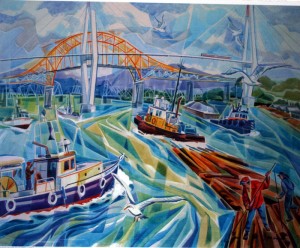 |
| Thank You Jack Campbell! |
? Another interesting question was raised by one of the participants at the tables rising from the data provided by TransLink. If the daily truck volume is 3,000 and the daily vehicle volume is 60,000, then less than 5% of the volume is actually trucks. 20 cars per truck. So why are we building a 24-hour dedicated truck lane each way? How much do we anticipate truck volumes growing? 3,000 a day is only 1 or 2 each way per minute. This seems like a lot of extra money for very few trucks. Or more frightening, does TransLink think the increase in trucks will be much, much larger? What impact will this have on New Wesmtinster?
Maybe I am getting mired in the details too much, and am missing the fundamental point here; and if so, perhaps TransLink is doing the same thing.
At all of these consultations, I have had friendly chats with TransLink Roads and PR staff, the consultation team from HB Lanarc Golder, and the representatives from the engineering firm that provided the conceptual design work. All of them say the same thing: we need to build a bigger bridge because traffic volumes are going up. Some people in the room disagree with this (as do, apparently, some members of New Westminster Council). So perhaps TransLink should not have sent their roads guys to come and consult with the City of New West on the topic of offramp shapes, but should have sent the Policy Guys to come and discuss the need for a bridge.
Perhaps the fundamental question we need answered is this: What is Translink’s Mandate? Is it to create the transportation system that people want, or that Kevin Falcon wants? Or is it to set transportation policy for the region? I always thought the latter, but the Act seems to suggest they carry both responsibilities. If so, shouldn’t the Policy part come before the building part?
TransLink’s policy document right now is Transport 2040. So before they send people to New Wesmtinster and Surrey to talk about offramps, they should come to our communities and have a discussion about how Transport 2040 fits our local conditions. Then we can talk about the type of bridge to build. As it is, building an expanded road bridge while Surrey and the Broadway Corridor wait for their long-promised mass transit investments seems to be a demonstration of a policy very diffrent than laid out in Transport 2040.
Michael Mann in Vancouver
As part of the AAAS meeting in Vancouver last week, Dr. Michael Mann gave a talk for the Pacific Institute for Climate Solutions. Not this Michael Mann , but this one.
You could Wiki this, but the short Bio is thus: Dr. Mann is a geophysicist and geologist who worked with a team of scientists who used a variety of proxy climate indicators (tree rings, coral growth patterns, ice cores, stalactite layers, etc.) to measure climate over the last 1000+ years. turns out the graph showed a sharp rise in temperatures in the Northern Hemisphere over the last 100 years. The graph was compelling enough, and the data robust enough, that I was included in the UN’s International Panel on Climate Change Third Assessment report.
Around that time, one of Mann’s co-workers used the expression “hockey stick” to describe the curve on the graph, borrowing the nickname from an older graph of atmospheric Ozone made by other scientists 20 years ago during another global atmospheric debate.
The graph was such a stark image, displaying our current situation in such clear terms, that is simply could not be left unaddressed by those who see Anthropogenic Climate Change as some sort of conspiracy.
Included in those people are several Canadians: Steve McIntyre ( a retired mining engineer) and Ross McKitrick (an economist) tried their hand at Climate Science and wrote a paper in a a fake science journal claiming the graph was the product of flawed science, and the battle for “Mann’s Hockey Stick” was on.
From the beginning of his talk, it is clear Dr. Mann is exactly what you would expect: a science geek, and a reluctant public figure. His speech was not polished or slick, the images not particularly compelling to a non-science audience, but it was an entertaining talk about how one guy doing proxy climate measurements can somehow become an enemy to some, just because he collected a little data on a topic that would become a political football.
In the last 10 years, this PhD Geologist who spends most of his time counting tree rings and teaching Earth Systems Science at Penn State, has had his e-mails stolen and publicized, Has been summoned to congressional hearings, investigated by his State Attorney General, been subject to academic kangaroo courts at his university, and accused of everything from perpetuating the “greatest hoax in the history of science” to outright fraud. Numerous investigations later, no-one has found any evidence of fraud or scientific misconduct.
But that doesn’t even matter, because one thing none of the people criticizing the “hockey stick” have done is collect any data that refutes it. They have instead spent so much energy and time trying to cast doubt on the veracity of the “hockey stick” that they have failed to acknowledge that there is an entire hockey league of sticks that are the same shape: measured atmospheric anthropogenic CO2, sea level change, ice extent, ocean temperatures, the list goes on.
In the end, Michael Mann is still a reluctant public figure (partly evidenced by his reluctance to take legal action against the people slandering him: he would rather just do science and find solutions). All he can do is keep reporting what he and other people doing the actual science have found. The scientific case is relatively straightforward; the greenhouse effect has been known for two centuries; we know human CO2 numbers are going up, and we know it is anthropogenic; we know earth has warmed more than 1 degree C over the last 100 years,and the trend is up. if you choose to ignore the thermometers, there are literally dozens of other lines of evidence: surface temps, permafrost loss, ocean stratification, and numerous observed biophysical reactions consistent with rapid warming. combine this with a distinct paucity of evidence against the trend, and it is remarkable anyone is still debating this.
The final point was one I have heard a lot recently: this is no longer a scientific debate, it is an ethical one. We need to make the ethical decision of whether we will burden the next generation and the one after with the unforeseen consequences of what we are doing today in the interest of Business as usual”. However, that’s s not a scientific question, it is a philosophical one. Once science has provided the data, what you do with it is not up to the Scientists.
Mann was quick to point out that the issue is not, as some suggest, the “politicization of science” (inherently, science is immune from politics, as its self-regulating mechanism will win out in the end), but the “science-ization” of politics, where a political position or immediate pragmatic need of a political group is mistaken for a scientific fact.
To beat this, we may need more reluctant scientists like Mann to take a more active part in the popular media, and provide the factual information we need to make rational decisions, informed by our ethics.
It’s the best hope we have to get past this strange, anti-science phase we are in right now in North American society.
Which is kind of what I think Neal Stephenson is getting into here:
